高考英语语法一点通课件——Lesson 14 主谓一致
文档属性
| 名称 | 高考英语语法一点通课件——Lesson 14 主谓一致 | 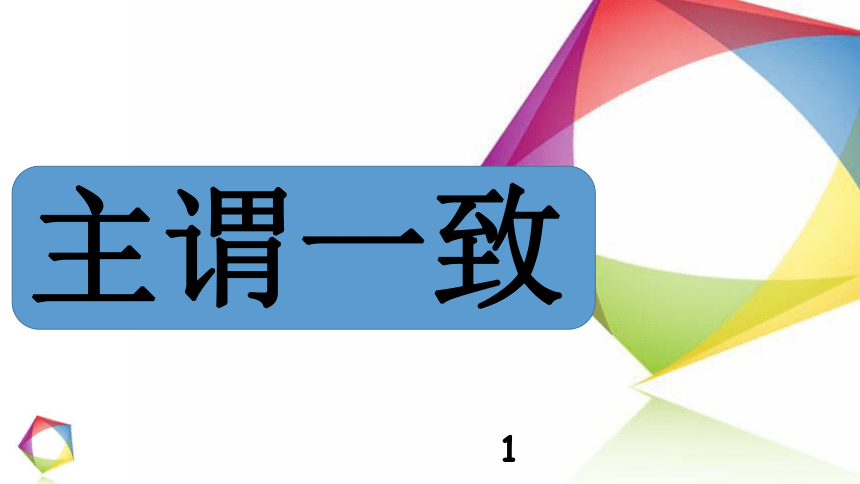 | |
| 格式 | pptx | ||
| 文件大小 | 259.6KB | ||
| 资源类型 | 试卷 | ||
| 版本资源 | 通用版 | ||
| 科目 | 英语 | ||
| 更新时间 | 2022-04-11 14:53:16 | ||
图片预览

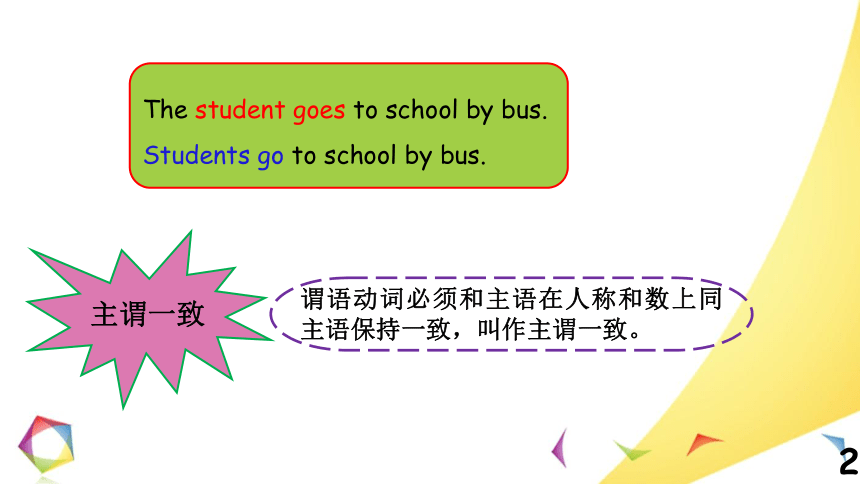
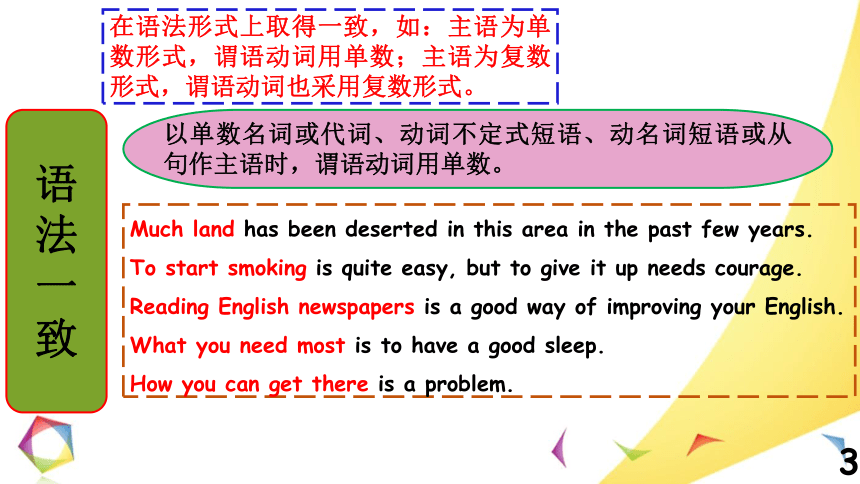
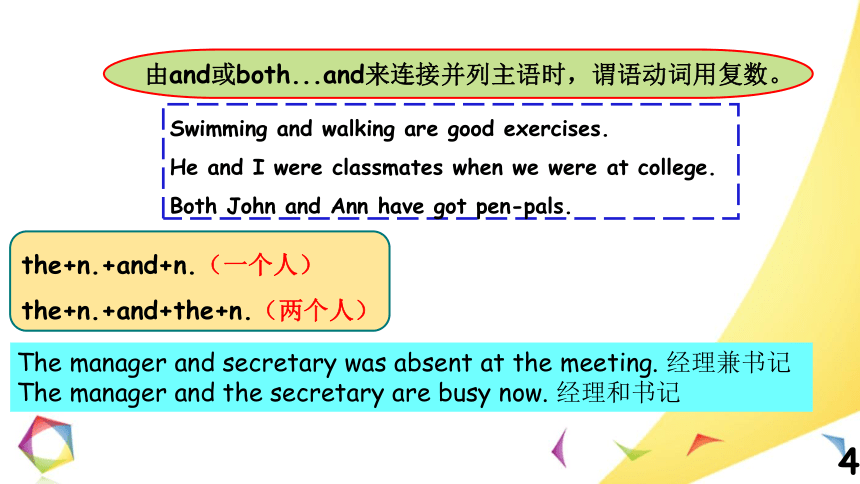
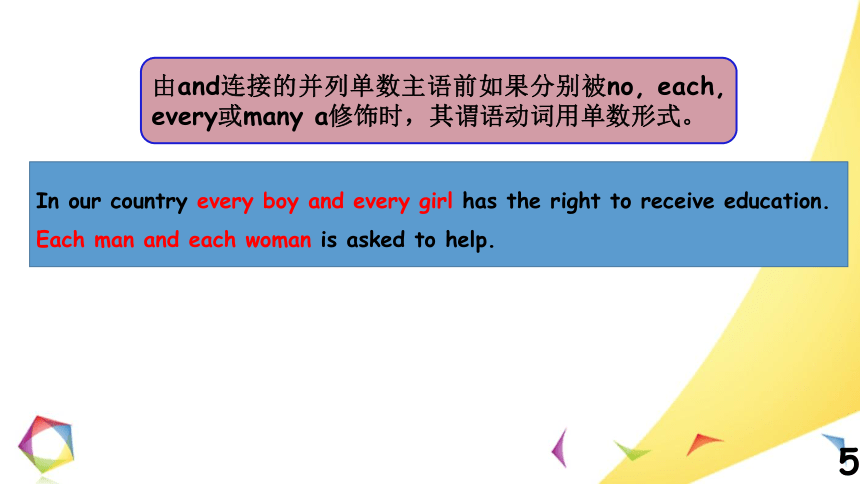
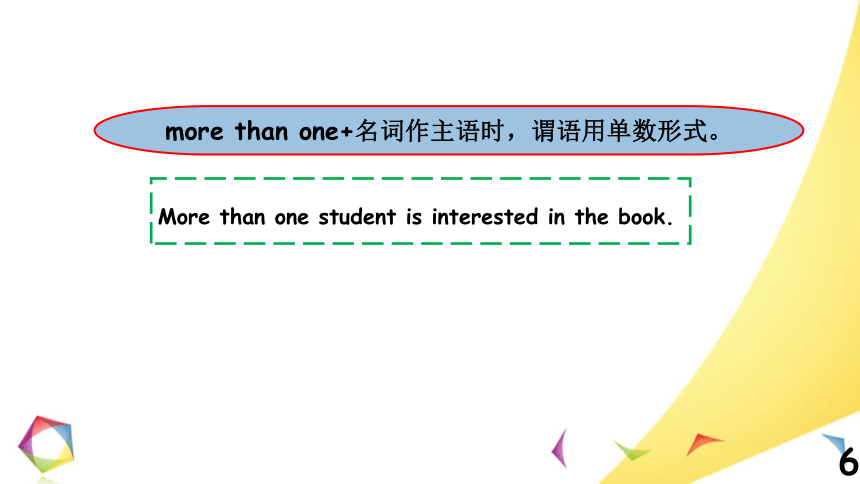
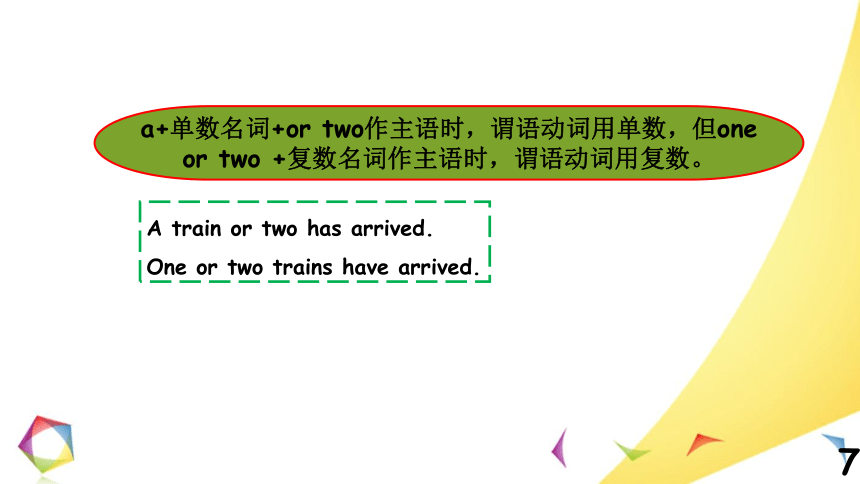
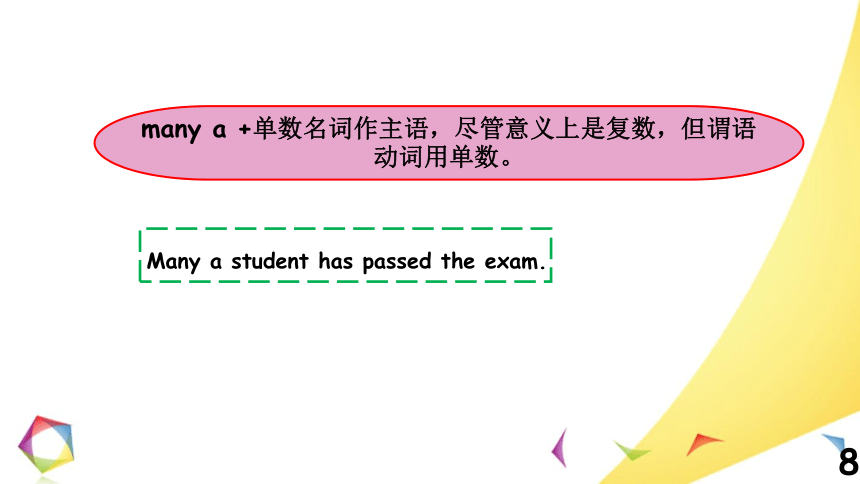
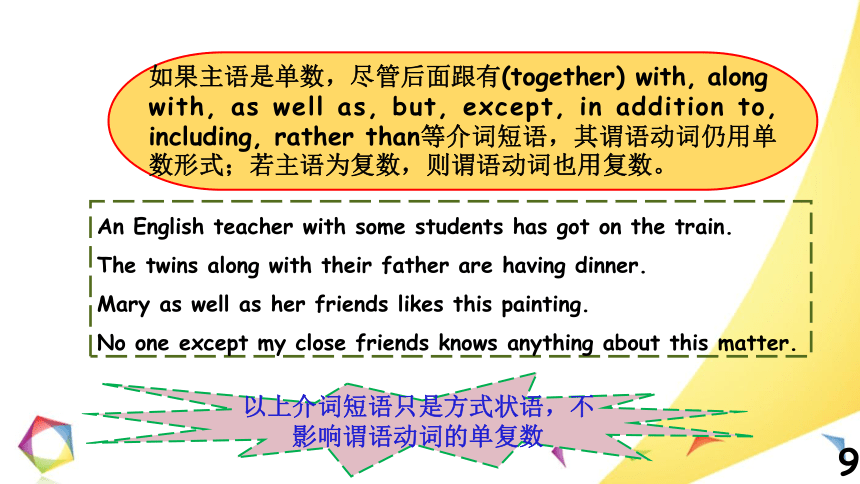
文档简介
(共29张PPT)
主谓一致Thestudentgoesto school by bus.Studentsgoto school by bus.主谓一致谓语动词必须和主语在人称和数上同主语保持一致,叫作主谓一致。语法一致在语法形式上取得一致,如:主语为单数形式,谓语动词用单数;主语为复数形式,谓语动词也采用复数形式。以单数名词或代词、动词不定式短语、动名词短语或从句作主语时,谓语动词用单数。Much landhas been deserted in this area in the past few years.To start smokingis quite easy, but to give it up needs courage.Reading English newspapersis a good way of improving your English.What you need mostis to have a good sleep.How you can get thereis a problem.由and或both...and来连接并列主语时,谓语动词用复数。Swimming and walking are good exercises.He and I were classmates when we were at college.Both John and Ann have got pen-pals.the+n.+and+n.(一个人)the+n.+and+the+n.(两个人)The manager and secretary was absent at the meeting. 经理兼书记The manager and the secretary are busy now. 经理和书记由and连接的并列单数主语前如果分别被no, each, every或many a修饰时,其谓语动词用单数形式。In our countryevery boy and every girlhas the right to receive education.Each man and each womanis asked to help.more than one+名词作主语时,谓语用单数形式。More than one student is interested in the book.a+单数名词+or two作主语时,谓语动词用单数,但one or two +复数名词作主语时,谓语动词用复数。A train or two has arrived.One or two trains have arrived.many a +单数名词作主语,尽管意义上是复数,但谓语动词用单数。Many a student has passed the exam.如果主语是单数,尽管后面跟有(together) with, along with, as well as, but, except,in addition to, including,rather than等介词短语,其谓语动词仍用单数形式;若主语为复数,则谓语动词也用复数。An English teacher with some students hasgot on the train.The twins along with their father are having dinner.Mary as well as her friends likes this painting.No one except my close friends knows anything about this matter.以上介词短语只是方式状语,不影响谓语动词的单复数不定代词each, either, neither和由 some, any, no, every构成的复合不定代词作主语时,谓语动词用单数。Each (of us) takes a cup of coffee.Everyone knows smoking cigarettes is bad for health.“a lot of , lots of, plenty of, the rest(majority)of, some(most, all等)of, 分数/百分数 of+名词”构成的短语作主语时,其谓语动词的数要与of后面的名词(短语)保持一致。Some of the sugar is wet.Most of the students in our class areChinese.Lots of damage was caused by smoking.Plenty of English books are on the shelf.Two thirds of the country is dry or desert.Two thirds of the people present are against the plan.all单独作主语表示“人”时,谓语用复数;表示“整个事件或事情”时,谓语用单数。All are presentat the meeting.Allgoes well.“a number of+复数名词”作主语时,谓语动词用复数形式;”the number of+复数名词”作主语时,谓语动词用单数形式。A number of students in our class are out by the lake.The number of students in our school is 2500.如果主语被kind of, pair of修饰,谓语动词的单复数取决于kind和pair的单复数。This kind of apples is rather expensive.Those kinds of apple trees have not yet grown up.There are three pairs of shoes on the shelf.在“one + of + the +复数名词+定语从句”结构中,定语从句一般视为修饰复数名词,故从句谓语动词用复数形式;但当one前面有限定词the,the only,the just等修饰时,定语从句应视为修饰one,故从句谓语动词用单数形式。That is one of the most famous books that have come out.He is theonlyone of the persons who witnesses the accident.意义一致谓语动词的单复数取决于主语所表达的内在涵义。表示总称意义的复数名词,如people, police, cattle等作主语时,只当作复数看待,谓语在任何情况下都用复数。The cattle are one cause of the problem.The police are searching for a murderer in that mountain.class,family,team等集体名词作主语时,主语被看作整体时,谓语用单数,指代个体成员时,谓语用复数。Our class is better than any other class at playing basketball.Our class arelistening to the teacher carefully.Our family is not poor any more.My family all speakChinese.一些由两部分构成名词作主语时,谓语动词通常用复数形式,如glasses(眼镜), trousers(裤子), shoes(鞋子),chopsticks(筷子), scissors(剪刀), socks(袜子), compasses(圆规),但如果这些名词前有a pair of等量词修饰时,谓语动词一般用单数形式。Your trousers need washing.My glasses are new.A pair of new shoes is in your suitcase.Two pairs of socks are enough for me.以-ics结尾的学科名词和疾病名词。如:statistics,acoustics,athletics,politics,mathematics,physics,ethics,measles,AIDS等是单数名词,谓语动词用单数形式。Mathematics is difficult for him to learn.Diabetes can cause death.Statistics is an important major at college.Economics is a study of production and consumption.当表示时间、金钱、距离、重量、长度、价值等数词短语作主语时,根据意义一致原则,通常被看作一个整体,其谓语用单数。Twenty years is a long timeforus.Five kilometres is not a long distance.如果主语由“the+形容词”担任时,往往根据意义一致原则,来决定谓语动词的单、复数形式。如果表示一类人时,谓语动用复数形式;如果指个人或抽象概念时,则谓语动词用单数形式。The old are taken good care of in our country.The beautiful lives forever.表示数量的短语“one and a half+名词复数”及“a+单数名词+and+a half”作主语时,谓语用单数。One and a half oranges has been left on the table.A month and a half has passed.以-ese、-sh、和-ch等结尾的表示民族及国籍的名词,表示总称,谓语动词用复数形式。The Japanese are brave and strong-willed.The Chinese are hard-working.population作为一个整体而言时,谓语动词用单数;当表示部分人口时,谓语动词用复数。The population in the country is larger than that in the city.Two thirds of the population in the city are workers.none of +不可数名词作主语时,谓语动词用单数形式,none of +复数名词作主语时,谓语动词可用单数或者复数形式。The baby cries for milk, but none is left in the bottle.I have invited fifty friends, but finally none have (has) come.None of the water is clean and drinkable.None of the pens write (writes) smoothly.a large/great/vast/good/small/amount(quantity)of+不可数名词,谓语动词用单数; large/great/vast/good/small/amounts(quantities) of +不可数名词,谓语动词用复数。A large amount of heat is sent from the sun.Large amountsof money were put in the bank.就近一致谓语动词的数随最近的主语而定,称为就近一致原则。当There be句型后面有两个或两个以上的名词时,be动词要和最靠近它的那个名词在人称和数上保持一致。There is a pen and two books on the table.=There are two books and a pen on the table.当or, either...or, neither...nor, not only...but also..., not...but....等连接两个并列主语时,谓语动词单复数取决于最靠近于它的名词或代词。Either you or Lily is to do the cleaning after supper.Not only the mother but also the children were there.倒装结构中的主谓一致在倒装句中,谓语动词要同主语保持一致。In front of the house stand two men.On the ground lies a boy.There stands a tower on the hill.1. We each _____ strong points and each of us on the other hand ______ weak points. A. have, have B. has, have C. has, has D. have, has2. When and where to build the new factory ______ yet.A. is not decided B. are not decidedC. had not decided D. have not decided3. Mary is the only one of the girls who________by the headmaster at the meeting.A. is praised B. are praisedC. was praised D. were praised4. Nobody except Bill and Johnny ______entered the second round of the interview.A. have B. has C. have been D. has been5.Mary as well as her sisters ______ Chinese in China.A. are studying B. have studied C. studies D. study
主谓一致Thestudentgoesto school by bus.Studentsgoto school by bus.主谓一致谓语动词必须和主语在人称和数上同主语保持一致,叫作主谓一致。语法一致在语法形式上取得一致,如:主语为单数形式,谓语动词用单数;主语为复数形式,谓语动词也采用复数形式。以单数名词或代词、动词不定式短语、动名词短语或从句作主语时,谓语动词用单数。Much landhas been deserted in this area in the past few years.To start smokingis quite easy, but to give it up needs courage.Reading English newspapersis a good way of improving your English.What you need mostis to have a good sleep.How you can get thereis a problem.由and或both...and来连接并列主语时,谓语动词用复数。Swimming and walking are good exercises.He and I were classmates when we were at college.Both John and Ann have got pen-pals.the+n.+and+n.(一个人)the+n.+and+the+n.(两个人)The manager and secretary was absent at the meeting. 经理兼书记The manager and the secretary are busy now. 经理和书记由and连接的并列单数主语前如果分别被no, each, every或many a修饰时,其谓语动词用单数形式。In our countryevery boy and every girlhas the right to receive education.Each man and each womanis asked to help.more than one+名词作主语时,谓语用单数形式。More than one student is interested in the book.a+单数名词+or two作主语时,谓语动词用单数,但one or two +复数名词作主语时,谓语动词用复数。A train or two has arrived.One or two trains have arrived.many a +单数名词作主语,尽管意义上是复数,但谓语动词用单数。Many a student has passed the exam.如果主语是单数,尽管后面跟有(together) with, along with, as well as, but, except,in addition to, including,rather than等介词短语,其谓语动词仍用单数形式;若主语为复数,则谓语动词也用复数。An English teacher with some students hasgot on the train.The twins along with their father are having dinner.Mary as well as her friends likes this painting.No one except my close friends knows anything about this matter.以上介词短语只是方式状语,不影响谓语动词的单复数不定代词each, either, neither和由 some, any, no, every构成的复合不定代词作主语时,谓语动词用单数。Each (of us) takes a cup of coffee.Everyone knows smoking cigarettes is bad for health.“a lot of , lots of, plenty of, the rest(majority)of, some(most, all等)of, 分数/百分数 of+名词”构成的短语作主语时,其谓语动词的数要与of后面的名词(短语)保持一致。Some of the sugar is wet.Most of the students in our class areChinese.Lots of damage was caused by smoking.Plenty of English books are on the shelf.Two thirds of the country is dry or desert.Two thirds of the people present are against the plan.all单独作主语表示“人”时,谓语用复数;表示“整个事件或事情”时,谓语用单数。All are presentat the meeting.Allgoes well.“a number of+复数名词”作主语时,谓语动词用复数形式;”the number of+复数名词”作主语时,谓语动词用单数形式。A number of students in our class are out by the lake.The number of students in our school is 2500.如果主语被kind of, pair of修饰,谓语动词的单复数取决于kind和pair的单复数。This kind of apples is rather expensive.Those kinds of apple trees have not yet grown up.There are three pairs of shoes on the shelf.在“one + of + the +复数名词+定语从句”结构中,定语从句一般视为修饰复数名词,故从句谓语动词用复数形式;但当one前面有限定词the,the only,the just等修饰时,定语从句应视为修饰one,故从句谓语动词用单数形式。That is one of the most famous books that have come out.He is theonlyone of the persons who witnesses the accident.意义一致谓语动词的单复数取决于主语所表达的内在涵义。表示总称意义的复数名词,如people, police, cattle等作主语时,只当作复数看待,谓语在任何情况下都用复数。The cattle are one cause of the problem.The police are searching for a murderer in that mountain.class,family,team等集体名词作主语时,主语被看作整体时,谓语用单数,指代个体成员时,谓语用复数。Our class is better than any other class at playing basketball.Our class arelistening to the teacher carefully.Our family is not poor any more.My family all speakChinese.一些由两部分构成名词作主语时,谓语动词通常用复数形式,如glasses(眼镜), trousers(裤子), shoes(鞋子),chopsticks(筷子), scissors(剪刀), socks(袜子), compasses(圆规),但如果这些名词前有a pair of等量词修饰时,谓语动词一般用单数形式。Your trousers need washing.My glasses are new.A pair of new shoes is in your suitcase.Two pairs of socks are enough for me.以-ics结尾的学科名词和疾病名词。如:statistics,acoustics,athletics,politics,mathematics,physics,ethics,measles,AIDS等是单数名词,谓语动词用单数形式。Mathematics is difficult for him to learn.Diabetes can cause death.Statistics is an important major at college.Economics is a study of production and consumption.当表示时间、金钱、距离、重量、长度、价值等数词短语作主语时,根据意义一致原则,通常被看作一个整体,其谓语用单数。Twenty years is a long timeforus.Five kilometres is not a long distance.如果主语由“the+形容词”担任时,往往根据意义一致原则,来决定谓语动词的单、复数形式。如果表示一类人时,谓语动用复数形式;如果指个人或抽象概念时,则谓语动词用单数形式。The old are taken good care of in our country.The beautiful lives forever.表示数量的短语“one and a half+名词复数”及“a+单数名词+and+a half”作主语时,谓语用单数。One and a half oranges has been left on the table.A month and a half has passed.以-ese、-sh、和-ch等结尾的表示民族及国籍的名词,表示总称,谓语动词用复数形式。The Japanese are brave and strong-willed.The Chinese are hard-working.population作为一个整体而言时,谓语动词用单数;当表示部分人口时,谓语动词用复数。The population in the country is larger than that in the city.Two thirds of the population in the city are workers.none of +不可数名词作主语时,谓语动词用单数形式,none of +复数名词作主语时,谓语动词可用单数或者复数形式。The baby cries for milk, but none is left in the bottle.I have invited fifty friends, but finally none have (has) come.None of the water is clean and drinkable.None of the pens write (writes) smoothly.a large/great/vast/good/small/amount(quantity)of+不可数名词,谓语动词用单数; large/great/vast/good/small/amounts(quantities) of +不可数名词,谓语动词用复数。A large amount of heat is sent from the sun.Large amountsof money were put in the bank.就近一致谓语动词的数随最近的主语而定,称为就近一致原则。当There be句型后面有两个或两个以上的名词时,be动词要和最靠近它的那个名词在人称和数上保持一致。There is a pen and two books on the table.=There are two books and a pen on the table.当or, either...or, neither...nor, not only...but also..., not...but....等连接两个并列主语时,谓语动词单复数取决于最靠近于它的名词或代词。Either you or Lily is to do the cleaning after supper.Not only the mother but also the children were there.倒装结构中的主谓一致在倒装句中,谓语动词要同主语保持一致。In front of the house stand two men.On the ground lies a boy.There stands a tower on the hill.1. We each _____ strong points and each of us on the other hand ______ weak points. A. have, have B. has, have C. has, has D. have, has2. When and where to build the new factory ______ yet.A. is not decided B. are not decidedC. had not decided D. have not decided3. Mary is the only one of the girls who________by the headmaster at the meeting.A. is praised B. are praisedC. was praised D. were praised4. Nobody except Bill and Johnny ______entered the second round of the interview.A. have B. has C. have been D. has been5.Mary as well as her sisters ______ Chinese in China.A. are studying B. have studied C. studies D. study
